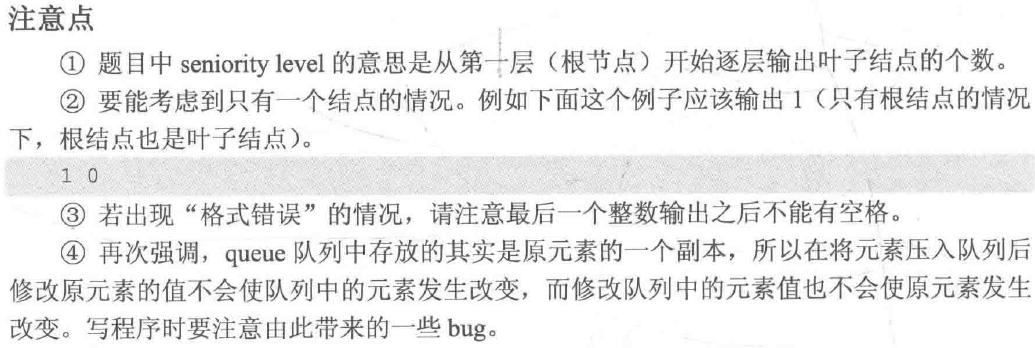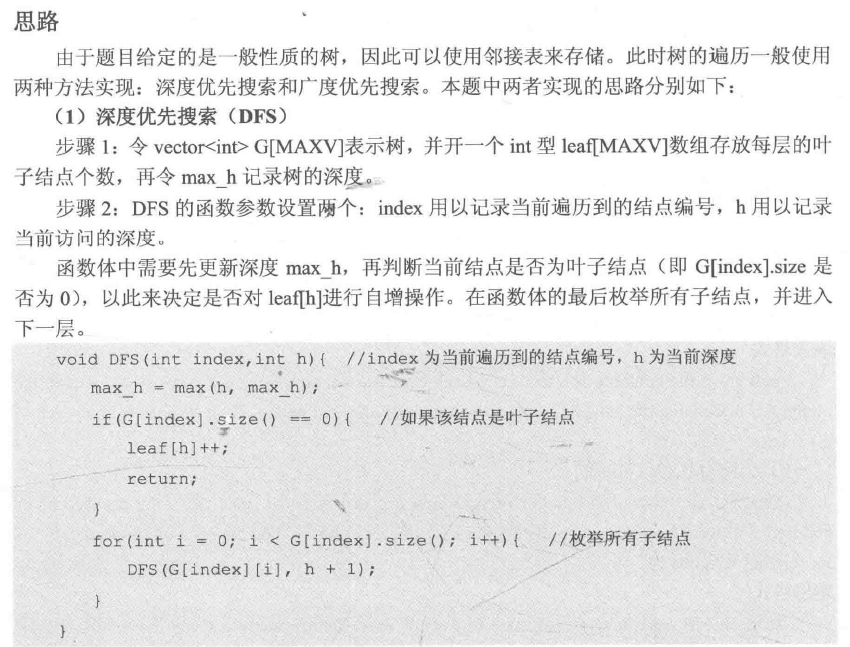A family hierarchy is usually presented by a pedigree tree. Your job is to count those family members who have no child.
Input
Each input file contains one test case. Each case starts with a line containing 0 < N < 100, the number of nodes in a tree, and M (< N), the number of non-leaf nodes. Then M lines follow, each in the format:
ID K ID[1] ID[2] ... ID[K]
where ID is a two-digit number representing a given non-leaf node, K is the number of its children, followed by a sequence of two-digit ID's of its children. For the sake of simplicity, let us fix the root ID to be 01.
Output
For each test case, you are supposed to count those family members who have no child for every seniority level starting from the root. The numbers must be printed in a line, separated by a space, and there must be no extra space at the end of each line.
The sample case represents a tree with only 2 nodes, where 01 is the root and 02 is its only child. Hence on the root 01 level, there is 0 leaf node; and on the next level, there is 1 leaf node. Then we should output "0 1" in a line.
Sample Input
2 1
01 1 02
Sample Output
0 1
生词
| 英文 | 解释 |
|---|---|
| family hierarchy | 家庭等级 |
| pedigree tree | 族谱 |
| The input ends with N being 0. | 输入以N为0结束。 |
| seniority | 年长 |
| every seniority level | 每一层次 |
题目大意:
给出一棵树,问每一层各有多少个叶子结点~
分析:
可以用dfs也可以用bfs~如果用dfs,用二维数组保存每一个有孩子结点的结点以及他们的孩子结点,从根结点开始遍历,直到遇到叶子结点,就将当前层数depth的book[depth]++;标记第depth层拥有的叶子结点数,最后输出~

原文链接:https://blog.csdn.net/liuchuo/article/details/52214833
DFS题解

#include <bits/stdc++.h>
using namespace std;
const int N=110;
vector<int> G[N]; //存放树
int leaf[N]={0}; //存放每层的叶子结点个数
int max_h=1; //树的深度
void DFS(int index,int h) //index为当前遍历到的结点编号,h为当前深度
{
max_h=max(h,max_h);
if(G[index].size()==0){ //如果该结点是叶子结点
leaf[h]++;
return;
}
for(int i=0;i<G[index].size();i++){ //枚举所有子结点
DFS(G[index][i],h+1);
}
}
int main()
{
#ifdef ONLINE_JUDGE
#else
freopen("1.txt", "r", stdin);
#endif
int n,m,parent,child,k;
scanf("%d%d",&n,&m);
for(int i=0;i<m;i++)
{
scanf("%d%d",&parent,&k); //父结点编号及子结点个数
for(int j=0;j<k;j++){
scanf("%d",&child);
G[parent].push_back(child); //加边
}
}
DFS(1,1); //初始入口为跟结点与第一层
printf("%d",leaf[1]);
for(int i=2;i<=max_h;i++){
printf(" %d",leaf[i]);
}
return 0;
}
BFS题解

#include <bits/stdc++.h>
using namespace std;
const int N=110;
vector<int> G[N]; //存放树
int h[N]; //各结点所处的层号,从1开始
int leaf[N]; //存放每层的叶子结点个数
int max_h; //树的最大深度
void BFS()
{
queue<int> Q;
Q.push(1); //将根结点压入队列
while(!Q.empty()){
int id=Q.front(); //弹出队首结点
Q.pop();
max_h=max(max_h,h[id]); //更新最大深度
if(G[id].size()==0){ //如果该结点是叶子结点
leaf[h[id]]++;
}
for(int i=0;i<G[id].size();i++){ //枚举所有子结点
h[G[id][i]]=h[id]+1; //子结点编号为G[id][i]
Q.push(G[id][i]); //将子结点压入队列
}
}
}
int main()
{
#ifdef ONLINE_JUDGE
#else
freopen("1.txt", "r", stdin);
#endif
int n,m,parent,child,k;
scanf("%d%d",&n,&m);
for(int i=0;i<m;i++)
{
scanf("%d%d",&parent,&k); //父结点编号及子结点个数
for(int j=0;j<k;j++){
scanf("%d",&child);
G[parent].push_back(child); //加边
}
}
h[1]=1; //初始化根节点
BFS(); //BFS入口
printf("%d",leaf[1]);
for(int i=2;i<=max_h;i++){
printf(" %d",leaf[i]);
}
return 0;
}